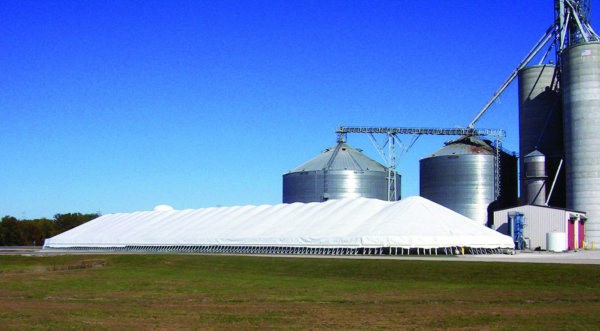USDA Temporary, Emergency Storage Regulations Unchanged For 2019 Harvest


From the July/August Grain Journal.
Harvest once again is approaching rapidly across the grain-growing regions of the United States, and some grain warehouse operators already are applying to the U.S. Department of Agriculture’s (USDA) U.S. Warehouse Act (USWA) for authorizations to pile grain outdoors in emergency or temporary storage.
And the rules remain unchanged from previous years, says Carie Cameron, chief of the License and Storage Contract Branch within the USDA Agricultural Marketing Service, Fair Trade Practices Program, Warehouse and Commodity Management Division (WCMD). Cameron spoke to Grain Journal in early July.
“The deadlines for removing grain from emergency storage are the same (March 31, 2020) and the same for temporary storage (March 31 for rice and soybeans, July 1, 2020 for wheat, corn, grain sorghum, and other feed grains),” she said.
Warehouse Operators Liability
Once authorized to use emergency and/or temporary space, warehouse operators are responsible for the quantity and quality of grain in emergency and temporary storage to the same extent as their liability for conventional storage space.
All grain stored in emergency and temporary space is considered a part of the commingled inventory.
USWA strongly recommends that warehouse operators review their security plans required under their License Agreement for Grain and Rice Warehouse Operators, as applicable to emergency and temporary storage spaces.
Warehouse Operator Requirements
Under either emergency or temporary storage licenses, the warehouse operator agrees to:
• Request and obtain licensing of emergency and temporary space prior to using it for storage.
• Operate the emergency and temporary storage space in conjunction with the USWA-licensed warehouse.
• Meet all security, net worth, financial assurance, and insurance requirements as required under USWA rules.
• Provide access to the emergency and temporary storage space for examination purposes.
• Maintain separate inventory records of each commodity stored in emergency and temporary storage space, as well as accounting for such commodities in their daily position report (DPR).
• Provide written notification within 30 days of the date when all the commodities stored in temporary and emergency storage space are removed.
Emergency Storage Requirements
For emergency storage, warehouse operators must:
• Provide written justification that a need for emergency storage exists for the current crop year in the local area, including the exact location, kind of commodity, and quantity requested.
• Receive authorization from Warehouse and Commodity Management Division (WCMD) before using emergency storage space.
• Move commodities into their USWA-licensed warehouse by March 31 following initial licensing for wheat, corn, grain sorghum, and other feed grains, and by other dates, as established by WCMD, for other commodities.
Temporary Storage Requirements
For temporary storage, warehouse operators must:
• Use asphalt, concrete, or other WCMD-approved base materials.
• Use rigid, self-supporting sidewalls.
• Provide adequate aeration.
• Provide an acceptable covering or tarp, as determined by WCMD.
• Move commodities into their USWA-licensed warehouse by March 31 of the following crop year for rice and soybeans; July 1 of the following crop year for wheat, corn, grain sorghum, and other feed grains; and other dates, as established by WCMD, for other commodities.
• Provide written notification before reusing licensed temporary space for another crop year.
Storage and Handling Rates
The storage and handling rates currently approved under the Uniform Grain and Rice Storage Agreement will apply. USWA will not pay any additional handling charges for grain moved into or out of emergency and temporary storage.
Contact
For more information or an application, contact Carie Cameron at the AMS License and Storage Contract Branch in Kansas City, MO; phone: 816-926-6474; email: warehousing@usda.gov.
A complete copy of the USWA Grain Licensing Agreement (WA-402) and its rules can be found on the USDA website.
If operating under a state license, contact the applicable state licensing authority to determine its requirements for the use of emergency and temporary storage.
Grain News
- FCA Board Receives Quarterly Report on Conditions in Agriculture and the Farm Credit System
- Growing the CHS Grain Supply Chain
- JDH Breaks Ground on New Grain Handling Facility in Sherman County
- NGFA: NASS Reports Are Critical to Agribusiness Operations
- Cargill And Nestlé Purina Partner on Regenerative Agriculture Adoption to Reduce the Carbon Footprint of Purina Dry Pet Food Products
- NASS Appoints Lance Honig as New ASB Chair
- KSU–GEAPS Grain Elevator Managers Course ... April 30-May 1 ... Manhattan, KS
- NAEGA Publishes Revised Export Contract For FOB at U.S. and Canadian Ports
- ALCIVIA Breaks Ground on Hager City, WI Train-Loading Facility
- CoBank Quarterly Report: Sticky Inflation Puts Federal Reserve on the Horns of a Dilemma